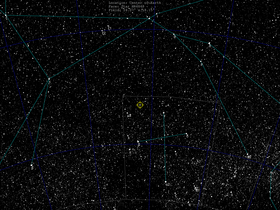 Star map shows star position on the northern edge of the constellation Crux | |
| Observation data Epoch J2000 Equinox J2000 | |
|---|---|
| Constellation | Crux |
| Right ascension | 12 46 22.71460 |
| Declination | −56° 29′ 19.7366″ |
| Apparent magnitude (V) | 4.62 |
| Characteristics | |
| Evolutionary stage | Main sequence |
| Spectral type | B2/3V |
| U−B color index | −0.61 |
| B−V color index | −0.150±0.003 |
| Astrometry | |
| Radial velocity (Rv) | 15.5 km/s |
| Proper motion (μ) | RA: −33.03 mas/yr Dec.: −14.84 mas/yr |
| Parallax (π) | 8.48 ± 0.22 mas |
| Distance | 385 ± 10 ly (118 ± 3 pc) |
| Absolute magnitude (MV) | −1.05 |
| Details | |
| Mass | 6.0±0.1 M☉ |
| Luminosity | 402 L☉ |
| Surface gravity (log g) | 4.24 cgs |
| Temperature | 16,780 K |
| Rotational velocity (v sin i) | 22±3 km/s |
| Age | 8.2±1.8 Myr |
| Other designations | |
| CPD−55°5215, FK5 3018, HD 110956, HIP 62327, HR 4848, SAO 240235 | |
| Database references | |
| SIMBAD | data |
HD 110956 is a single star in the southern constellation of Crux. It is faintly visible to the naked eye with an apparent visual magnitude of 4.62. The distance to this star is approximately 385 light years based on parallax and it is drifting further away with a radial velocity of 15.5 km/s. It is a probable member of the Lower Centaurus–Crux subgroup of the Scorpius–Centaurus association.
This is a B-type main-sequence star with a stellar classification of B2/3V. It is a young star, estimated to be about 8 million years old, with six times the mass of the Sun. The star is spinning with a projected rotational velocity of 22 km/s. It is radiating around 400 times the luminosity of the Sun from its photosphere at an effective temperature of 16,780 K.
There are multiple visual companions positioned near HD 110956. The brightest of these, with a visual magnitude of 8.93, is located at an angular separation of 51.1″ along a position angle of 166°, as of 2020. This companion was reported by J. F. W. Herschel in 1834. It is an α CVn variable with the designation BR Cru.
References
- ^ van Leeuwen, F. (2007). "Validation of the new Hipparcos reduction". Astronomy and Astrophysics. 474 (2): 653–664. arXiv:0708.1752. Bibcode:2007A&A...474..653V. doi:10.1051/0004-6361:20078357. S2CID 18759600.
- ^ Anderson, E.; Francis, Ch. (2012). "XHIP: An extended hipparcos compilation". Astronomy Letters. 38 (5): 331. arXiv:1108.4971. Bibcode:2012AstL...38..331A. doi:10.1134/S1063773712050015. S2CID 119257644.
- ^ Houk, N.; Cowley, A. P. (1975). University of Michigan Catalogue of two-dimensional spectral types for the HD stars. Volume I. Declinations -90_ to -53_ƒ0. Bibcode:1975mcts.book.....H.
- ^ Evans, D. S. (June 20–24, 1966). "The Revision of the General Catalogue of Radial Velocities". In Batten, Alan Henry; Heard, John Frederick (eds.). Determination of Radial Velocities and their Applications, Proceedings from IAU Symposium no. 30. University of Toronto: International Astronomical Union. Bibcode:1967IAUS...30...57E.
- Kaltcheva, N. T.; et al. (2014). "Massive stellar content of the Galactic supershell GSH 305+01-24". Astronomy and Astrophysics. 562: A69. arXiv:1312.5592. Bibcode:2014A&A...562A..69K. doi:10.1051/0004-6361/201321454. S2CID 54222753.
- ^ Tetzlaff, N.; et al. (January 2011). "A catalogue of young runaway Hipparcos stars within 3 kpc from the Sun". Monthly Notices of the Royal Astronomical Society. 410 (1): 190–200. arXiv:1007.4883. Bibcode:2011MNRAS.410..190T. doi:10.1111/j.1365-2966.2010.17434.x. S2CID 118629873.
- ^ McDonald, I.; et al. (2012). "Fundamental parameters and infrared excesses of Hipparcos stars". Monthly Notices of the Royal Astronomical Society. 427 (1): 343–357. arXiv:1208.2037. Bibcode:2012MNRAS.427..343M. doi:10.1111/j.1365-2966.2012.21873.x. S2CID 118665352.
- de Geus, E. J.; et al. (June 1989), "Physical parameters of stars in the Scorpio-Centaurus OB association", Astronomy and Astrophysics, 216 (1–2): 44–61, Bibcode:1989A&A...216...44D
- ^ Bragança, G. A.; et al. (November 2012). "Projected Rotational Velocities and Stellar Characterization of 350 B Stars in the Nearby Galactic Disk". The Astronomical Journal. 144 (5): 10. arXiv:1208.1674. Bibcode:2012AJ....144..130B. doi:10.1088/0004-6256/144/5/130. S2CID 118868235. 130.
- Eggleton, P. P.; Tokovinin, A. A. (September 2008), "A catalogue of multiplicity among bright stellar systems", Monthly Notices of the Royal Astronomical Society, 389 (2): 869–879, arXiv:0806.2878, Bibcode:2008MNRAS.389..869E, doi:10.1111/j.1365-2966.2008.13596.x, S2CID 14878976.
- de Zeeuw, P. T.; et al. (January 1999), "A HIPPARCOS Census of the Nearby OB Associations", The Astronomical Journal, 117 (1): 354–399, arXiv:astro-ph/9809227, Bibcode:1999AJ....117..354D, doi:10.1086/300682, S2CID 16098861
- Mason, Brian D.; et al. (2001). "The 2001 US Naval Observatory Double Star CD-ROM. I. The Washington Double Star Catalog". The Astronomical Journal. 122 (6): 3466. Bibcode:2001AJ....122.3466M. doi:10.1086/323920.
- Samus', N. N.; et al. (2017). "General catalogue of variable stars". Astronomy Reports. 5.1. 61 (1): 80–88. Bibcode:2017ARep...61...80S. doi:10.1134/S1063772917010085. S2CID 125853869.
| Constellation of Crux | |||||||||||
|---|---|---|---|---|---|---|---|---|---|---|---|
| Stars |
| ||||||||||
| |||||||||||
| |||||||||||
| |||||||||||